- Foreign Policy
- Arms Race
- Student Arguments on Foreign Policy
- Cult of Personality
- Economy
- Opposition
- Revision and Student Perspectives
Foreign Policy
This section should be studied for the Move to Global War too.
1923 Corfu invaded and Italy receive fifty million lire in compensation.
1924 Yugoslavia gives Fiume to Italy via the Treaty of Rome, recognises the USSR as a country.
1925 Locarno Pact signed, confirming Europe’s borders
1926 Treaty with Spain and de Rivera
1928 Italian & Ethiopian Treaty of Friendship, Kellogg-Briand Pact
1933 Four-Power Pact signed (Germany, Italy, Britain & France). Italy also signed
1935 Stresa Front signed, reaffirming Locarno
1935-37 Abyssinia invaded in 1935 with 500 000 Italian troops.
1936 Mussolini no longer objects to the Anschluss, Abyssinia taken, Rome-Berlin Axis.
1936-39 Spanish Civil War
1937 Italy joins the Anti-Comintern Pact & withdraws from the League
1939 Mussolini invades Albania, Pact of Steel signed with Germany.
1940-44 Second World War, Italy joins in 1940 by attacking Egypt from its colony of Libya.
Explanation of Mussolini’s Foreign Policies
- Mussolini’s foreign policy in the 1920s was aimed at restoring Italy’s international reputation. He agreed to uphold the post-war peace treaties to get respect from Europe’s governments. However, it was also practical for Mussolini to focus on the domestic political and economic problems of Italy instead of beginning an aggressive foreign policy.
- Italy’s improved status would then allow her to re-negotiate the lands she thought she should have been given at the Treaty of Versailles (see Treaty of London 1915 at the top of the page).
- Italy’s rivals were Austria, France and newly-formed Yugoslavia (the latter two in particular as Mussolini despised them both. In turn, they developed a strong relationship to keep Italy in check. Ironically, Germany’s increasing military power from 1933 brought France, Yugoslavia and Italy closer together). He also hated the League of Nations, feeling that it was had no power.
- John Gooch argues that Mussolini had territorial ambitions but they were on hold until the time was right, he wanted a strong Germany to curtail the power of France and then take advantage in the Balkans and North Africa. However, he did not want Germany to be too powerful so instigated the Four-Power Pact in 1933. This would further the impression that Italy was not aggressive and mean that German rearmament was increased slowly. However, the four powers could not agree and it failed.
- Mussolini’s attack on Abyssinia was mainly driven to avenge Italy’s defeat in 1896. He had been planning this since 1932 but the armed forces were not yet ready. He was prepared in 1934 because he knew Abyssinia was building up her army so had to act quickly, Britain would not act to stop him, and that France supported his actions because they feared the growing power of Germany.
- The war ended in 1936 with a victory but his use of poison gas disgusted the Europeans. However, the garrisoning of troops limited Italian military power in the Second World War.
- In the same year, Mussolini agreed to aid the nationalists in the Spanish Civil War. He acted because he despised the communists and growing Soviet influence in Europe, he sought a growing influence in the Mediterranean with Spanish help when they were successful, and he realised that Italian contributions would strengthen the political relationship with Germany.
- However, Mussolini thought the Spanish Civil War would be short. Unfortunately for him, the war took three years and cost Italy both financially and militarily. One benefit was that his armed forces gained much-needed experience to fight future wars.
- The Rome-Berlin Axis and Anti-Comintern Pact were signed in 1936 too. These broke the relations Italy had with Britain and France.
- The Anchluss of 1938 would have been a problem for Italy in the past as it strengthened Germany and could have been a major threat to Italy. However, Mussolini supported it due to his growing political, economic and military relationship with Germany.
- The Pact of Steel was signed in 1939. Mussolini wanted Japan to join but it did not want to commit to viewing Britain and France as enemies, it agreed to the USSR, however. Therefore, only Italy and Germany signed this alliance.
- Mussolini was encouraged by the Pact but was aware that Germany may take too much territory, including the Balkans (which he had wanted), but was acquiesced when he met Hermann Goering.
- John Gooch – Mussolini had sought war to further Italian ambitions for years and finally joined the Second World War in June 1940. However, his military commanders warned him that they were not ready. This would prove a costly error as the Italians were easily defeated in North Africa.
Opportunist Perspective
Intentionalist Perspective
Structuralist Perspective
Arms Race
Joseph Maiolo on Mussolini and Italy in Cry Havoc, How the Arms Race Drove the World to War, 1931-41.
- In November 1917, a few months after the infamous defeat at the Battle of Caporetto, Mussolini wrote that whilst Britain, France and Germany had regimented their entire economies and societies, Italy had been half-asleep. If Italy was to win the war, every man and woman must be used. Caporetto was not a military blunder but a verdict on the entire nation. “Italy had failed to mobilise the totality of its material, physical and mental resources. The lesson would guide his politics from then on.” Page 60
- Once in power, the army and other elites of Italy could have deposed Mussolini but chose not to. The relationship between the army and Il Duce was always uneasy, the former swore loyalty to the king rather than the dictator, and they did not see the Blackshirts as anything other than thugs (Mussolini understood this and limited the movements during the Matteotti crisis so they would not anger the army – similar to Hitler and the SA in 1933). But what drew them together were their future plans for war and how it was to be fought.
- The 1914-18 conflict demonstrated that no longer was war between armies but nations. They had to mobilise all their strength to win. The post-war politicians did not see this future but the Fascists clearly did. They even adopted the term totalitarianism to prove to themselves that their vision was a complete militarised society.
- But a characteristic of Mussolini’s Fascism was that of self-sufficiency or autarky. He believed this would prepare Italy for war and, in being less reliant on foreign powers for resources, would make it stronger and more resilient. However, it could also have been a factor in their defeat in the Second World War.
- Once in office, Mussolini began to prepare for total war. The corporate state was part of this plan, large industries could take control of the economy in times of war. He also launched the battles for wheat and births to prepare the country for total war.
- Mussolini also increased the military, building 800 aircraft by 1926, second only in size to France. But as the economy of Italy could not keep pace with the French, their aircraft could not evolve and the Italians fell behind in technological prowess.
- Marshal Badaglio was appointed chief of staff of the armed forces. He did not see the practicality of a future war as Italy was limited in its resources to fight one. According to Maiolo, Badaglio did not have the romantic view of war like Blomberg (Germany), Ishiwara (Japan) or Tukachevsky (USSR).
- Mussolini wanted a war against Yugoslavia but Badaglio had not prepared or planned the Italian armed forced for such a conflict, especially as France had sold them large shipments of modern armaments and was considered an ally too.
- The Great Depression, which the Fascists argued had not hit Italy very hard because of their autarky policies, severely affected the country; unemployment rose to a million and industrial production fell by a third. Italian banks went bust and this affected the arms industry, Mussolini’s solution was to nationalise the Bank of Italy so corporate government grew further.
- However, at the World Disarmament Conference in 1932, Mussolini and his foreign minister, Gradi, wanted its success. The reason – opportunism. If the major powers of the world halted arms production, it would prevent Italy’s rivals overtaking them.
- Mussolini’s strategic thinking during the 1930s was this – support German rearmament as this will lead to tension and possible conflict with France. This will turn French attention away from its ally Yugoslavia, and allow Italy to defeat it in a war.
- But he did not want Germany to ally with Austria as this could be threat to his own power. And he did not want them to rearm too quickly. For this reason, he proposed the Four-Power Pact in 1933. This would guarantee that Germany, France, Britain and Italy could discuss colonial issues and, importantly, limit German rearmament to stages. Hitler’s diplomats only paid lip-service to this idea and the Pact did not get the full cooperation of the other members too.
- When Mussolini met Hitler in 1934, they discussed limiting Germany’s rearmament; Hitler objected.
- Events altered their relationship when in July the Austrian Chancellor Dollfuss was shot dead by Austrian Nazis. Mussolini reacted by sending troops to the border and warned his chiefs of staff that Germany was now a major rival.
- Mussolini had requested war plans for Ethiopia (Abyssinia) since 1932. But these were shelved temporarily as Yugoslavia became his focus. However, as Ethiopia became stronger due to their military spending and and training, he changed his mind and decided a preventative war was required to protect Italy’s colonies.
- This move was made knowing full well that Europe was at peace and wanted to remain that way. He also knew that Britain would not act as he had acquired top-secret documents from them outlining their lack of concern for Ethiopia. This was extremely important as the Italian general staff knew there was only one winner from an Anglo-Italian war. Yet even with the British acknowledging this this result
Student Arguments
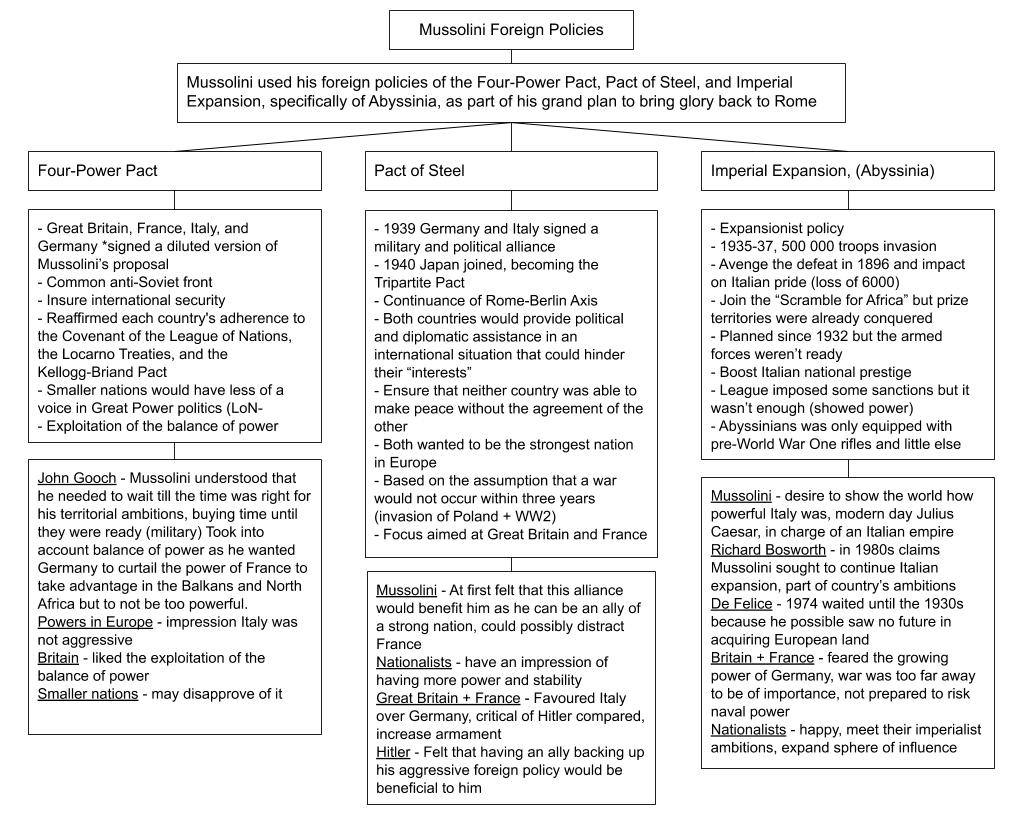
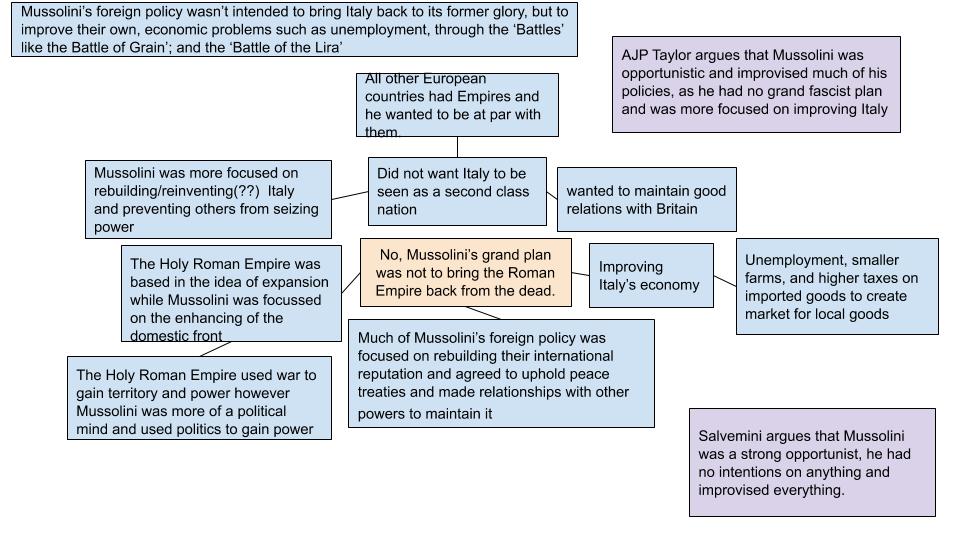
Cult of Personality
- De Felice said Mussolini had a genius for propaganda. However, one could argue that the strength of Mussolini’s cult was that it was not the state who published it, the population produced their own such was their devotion to Il Duce.
- It was a tool to keep the Fascists in check and force them to regularly speak highly of their leader.
- It was also a system to organise the population. With its focus on Mussolini as the perfect warrior and hero, he would serve as a role model for others and prepare them for war.
- His speeches were rehearsed to ensure the maximum effect. They were very effective because he worked tirelessly. Memories of them would last for years afterwards.
- When visiting a town, Mussolini would deliver a speech, inspect a factory and speak to the people individually and in groups. Importantly, they were photographed and filmed for a wider audience.
- As religion was very much part of Italian society, Mussolini tried to make himself a saviour or saintly figure.
- Schools had textbooks written by the state, the curriculum developed to be politically friendly to the Fascists and teachers ‘supervised’ to ensure it was delivered correctly. Students were also encouraged to take part in paramilitary groups which would further the ideological support for fascism.
- Many letters were sent to Mussolini from children although Paola Bernasconi argues that they could have been as classroom tasks by Fascist-supporting teachers.
- However, Mussolini did not create a population which followed his ideology absolutely although this may have been because of the failure of some of his economic and foreign policies, not the failure of his cult of personality.
Economy
Although this topic is important to Unit 14 – Interwar Years, it also helps you understand how Mussolini consolidated his power.
Do you think this video shows you an accurate portrayal of the Italian economy? Think about OPVL when answering this.
- Mussolini’s economic policy was clearly not capitalist, as the quote below proves.

- The Italian economy suffered because of the First World War, leading to debt quadrupling, inflation at 560% and unemployment reaching two million. This was in contrast to the decade before the war when the economy prospered.

- In the second half of 1922, the global economy grew and this helped Italy too. Taxes for foreign investment were cut and trade agreements were negotiated. However, the finance minister who helped to achieve this was sacked because he grew in popularity (De Stefani).

- How socialist was Mussolini’s economic policies? The Socialist Economics of Italian Fascism
- From 1926 Mussolini knew that he had dictatorial powers to make changes to the country and to the economy. He neutralised the trade unions (the Vidoni Palace Pact meant that there was only one trade union, the Fascists, this endeared him to the industrialists), introduced the Rocco Law to make strikes illegal and gave power to industries who would manage the workers for the country – corporatism. Wages, conditions, hours of work, productivity, benefits and reasons for dismissal would be decided by the corporate body.
- The Fascist trade union, led by Edmondo Rossini, wanted to have more influence than it was given but Mussolini sided with the industrialists rather than his party associate. Employers were able to alter working conditions at will as a result.
- The corporations numbered 22 by 1934, controlling most aspects of the economy. They were led by councils, in which employers and employees were members, some fascists too. The purpose was to eliminate industrial problems, allowing all stakeholders to work together. However, the power was clearly in the hands of both the employers and fascists, and criticism from employees was merely suppressed.
- It was successful to the outside world (via propaganda) but it led to huge bureaucracy and annoyed the workers who had less freedom to negotiate pay and work conditions.
- Between 1926 and 1934 real wages slumped by at least 50%. To counter it, the government introduced Dopolauoro. This was a programme to create cheap and accessible leisure activities.
- Mussolini continued to use rhetoric to maintain support for his policies. He used the term’Battles’ to promote new economic policies: Battle for the Lira (1926-38), Battle for Grain (1925-39) and the Battle for Land (1926-1938).
Battles
- Battle for the Lira – the lira was revalued to increase its strength, changing the exchange rate of 150 lira to the pound to 90 in 1927. A strong country has a strong currency! This was successful in terms of reducing inflation but failed because it raised unemployment. It made exports industries twice as expensive. However, this turned about to be an advantage when the Great Depression hit, they did not have to rely on export markets as much as the industrial powers.
- The revaluation should have made imports cheaper but this was not the case because Mussolini imposed high tariffs on them, forcing consumers to buy only Italian-made goods. He kept faith with his fascist belief of autarky but this was at the expense of his people.
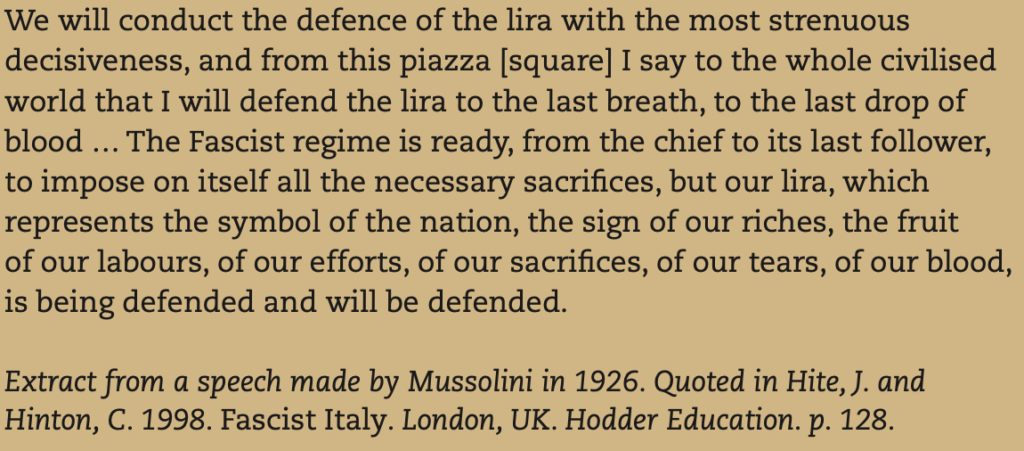
- Battle for Grain – High tariffs were placed on food imports and people were given financial incentives to cultivate land and grants given to buying machinery. However, export crops (olive oil) collapsed and the South of the country suffered through soil erosion. Many of the poorer farmers suffered too.
- Battle for Land – Marshland was to be cleared and reclaim any that could be used for agriculture. War veterans benefitted from this policy as they were allocated some of the 80 000 hectares which were made available. Moreover, two new towns (Saubadia and Latina) were showcased to demonstrate Italian achievement. However, only 5% of the land the government said was available actually was and the land was generally infertile.
- The Battle for Births began in 1927. Mussolini wanted a larger population for security purposes but also to grow the economy. He offered incentives such as maternity benefits and prizes, and arguably punishments for not producing children – bachelors had to pay higher taxes. Mussolini wanted to encourage women to give up their jobs. and take on the role of a full-time mother. In this he was unsuccessful, one-third of women were still employed by 1940. Addiotnally, the number of births actually declined – dropping from 29.9 per 1000 in 1925 to 23.1 in 1940.
The Great Depression
- The Great Depression hit Italy in 1931. Major banks collapsed (Bank of Milan) as did major foreign creditors in their economy. Moreover, over 1.3 million were unemployed by January 1932, 2 million the following year.

- However, the finance minister, Antonio Mosconi, created the Sofindit (October 1931) and the IMI (November 1931), which stabilised the economy and made credit avaiÌable.
- Furthermore, Alberto Beneduce took charge of the Institute for Industrial Reconstruction (lRI) and it gained control of large heavy industries in Italy as a solution to the economic crisis. The fascist state bailed out many Italian businesses and became the major shareholder through IRI, increasing its control of the country.
- Finally, it also organised the building of rail and road, power stations and even deluxe liners to alleviate the unemployment situation. As the Fascists had huge control of their economy through the corporate state, they were able to implement these changes. Western economies relied on laissez-faire measures so were less able to do so. However, leaders such as Roosevelt in the US were impressed with Mussolini’s economic policies to deal with the Depression and copied a few of them for his New Deal.
Mussolini’s Imperialism
- 1936 changed things. Mussolini and the Fascists no longer advocated economic stability as their imperialist ambitions took over. The war in Abyssinia destabilised the lira and the rearmament costs (costing one-third of government spending) led to increased taxes being levied on the country. However, as Italy was less reliant on foreign trade through his policy of autarky, the League’s sanctions did not hurt as much as they may have.
- Italian aid in the Spanish Civil War also depleted Italian coffers leading to industrialists and financiers to criticise the government.
- The Pact of Steel was signed in 1939 and Mussolini was advised not to go through with his obligations by the finance minister Revel.
Economic Leadership Secrets of Benito Mussolini
Socialist Economics of Italian Fascism
1936 – Italy came off the gold standard, this was later than most.
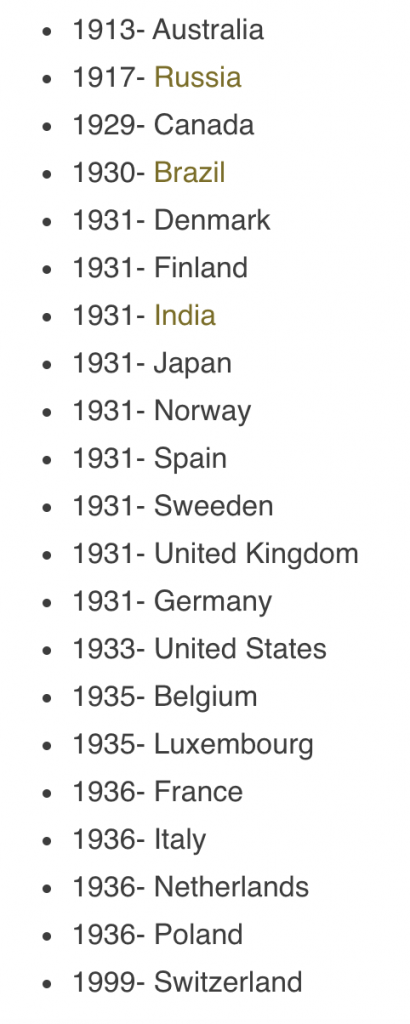
- Italy’s entry into the Second World War in 1940 did not help the economy. The country was not completely self-sufficient in resources (to be fair, which is even today?) as it needed oil and steel. Therefore, imports were still required and it became reliant on Germany as a result during the war.
- The economy was not ready for war with spending outweighing income increasingly towards the end of the 1930s. Mussolini could have increased taxes to make up this shortfall but this would prove unpopular and he did not do so. This indicates a limit to his power.
- Mussolini’s interference did not help.
Were Mussolini’s economic policies successful?
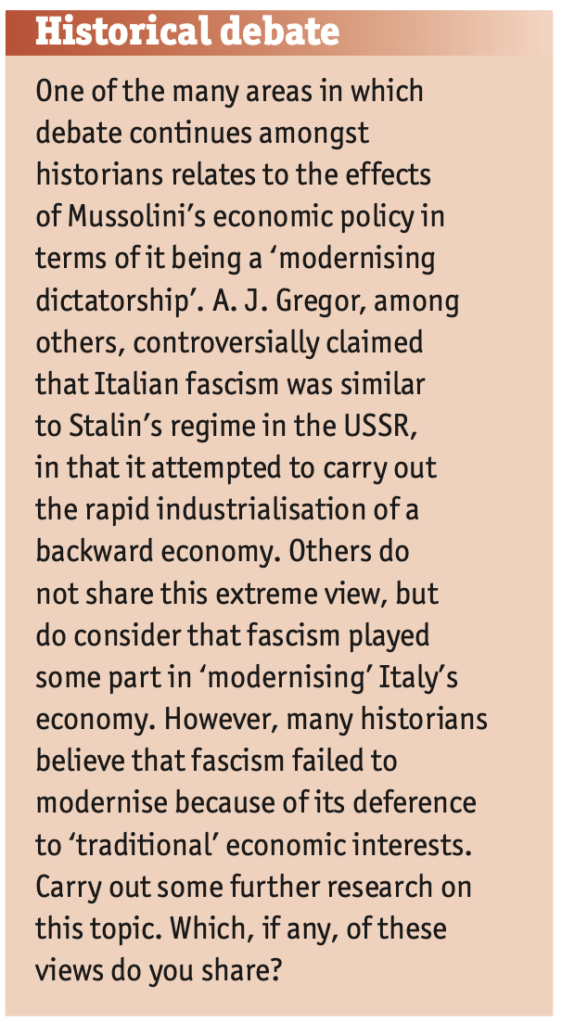

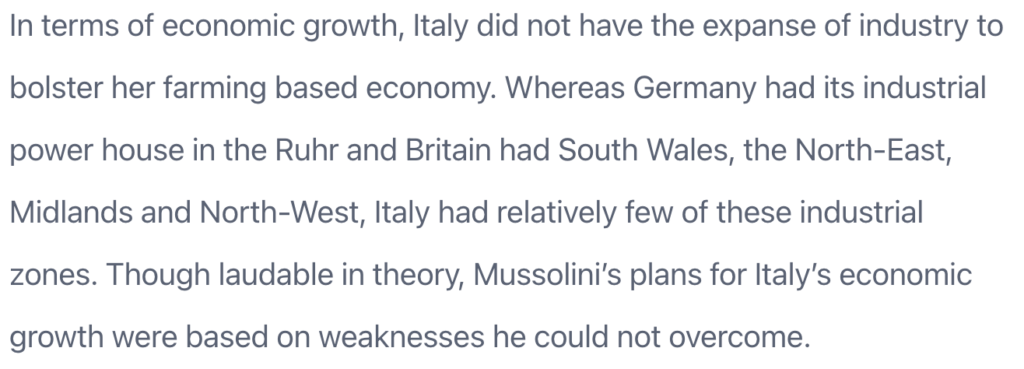

6. Opposition
- Industrial Strikes from 1940, as Mussolini’s military adventures continued, the economy worsened and thousands of workers responded.
7. Revision and Student Perspectives
